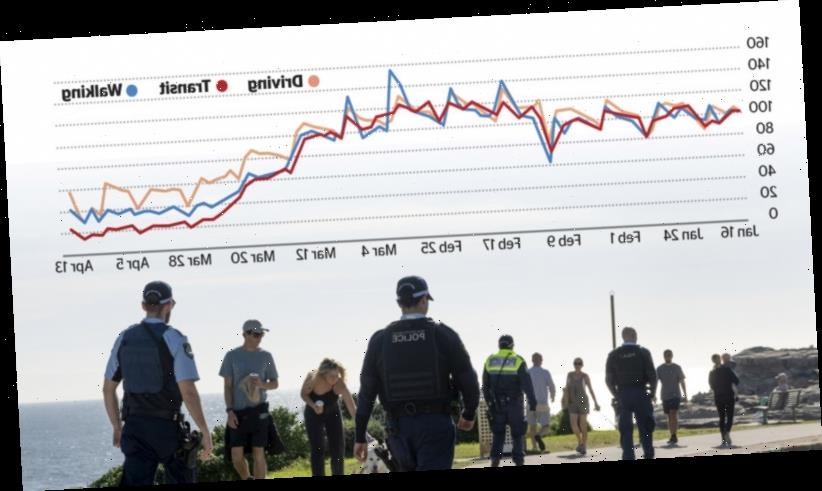People in Sydney are travelling more than those in Melbourne since lockdown orders began, new data released by Apple and Google shows.
Across NSW, people are visiting parks and beaches 27 per cent less than they were before lockdowns began compared to a 75 per cent drop in visits to these places by Victorians, Google data shows.
And every day since major lockdown measures were introduced on March 23, Sydney has been further above a baseline rate of requests to Apple Maps for routes to places than Melbourne.
The number of people using Apple Maps, which is installed on all iPhones, to navigate in their cars fell by 70 per cent in Sydney and 80 per cent in Melbourne on Saturday, compared to a baseline date in mid-January.
In Melbourne, Apple’s data shows driving route requests are down 53 per cent, walking requests down 61 per cent and transit requests, such as for buses and taxis, down 83 per cent since mid-January. In Sydney, driving route requests to Apple Maps are down 42 per cent, walking requests down 58 per cent and transit requests down 77 per cent.
The changes in major cities and 63 countries detailed in the Apple data shows how much lockdowns reduce travel plans in places that have quarantined their populations such as Italy and New Zealand.
Changes in travel route requests by car in Australia and the US are trending more closely after vast differences were recorded last week.
Apple's data is more limited than that which Google has made available in more than 131 countries, comparing trips to recreational venues, train and bus stations, grocery stores and workplaces with a five-week period between January 3 and February 6, 2020.
The Google mobility trends record how visits and length of stay at different places change compared to a corresponding baseline day of the week.
In NSW, visits to places such as national parks, beaches, marinas, dog parks, plazas and public gardens have dropped just 27 per cent compared to the baseline up to April 5. But in Victoria there has been a fall of 75 per cent, indicating Victorians are visiting parks and beaches about one-quarter as often as they did.
Apple and Google do not provide the absolute number of requests or a specific number of people moving, instead expressing the data as a percentage of requests compared with a baseline.
Professor of Communications and Media at Monash University Mark Andrejevic said Google has been "working its way into health care from a variety of directions".
"It's a reminder that Google has all this information – and much more – about all of us who use their services," Prof Andrejevic said. "The virus provides a social license to use its information for new purposes such as contact tracing and monitoring public response to mobility restrictions."
The federal government is hoping a coronavirus app to track Australians movements to help understand and reduce COVID-19 infections will be available in two weeks, following technology already used in Singapore.
Aggregate data can help protect people's privacy but still identifies travel patterns thus avoiding mistakes of countries such as South Korea, which were criticised for privacy violations, says Jason Farley, professor at Johns Hopkins University School of Nursing.
Farley, an infectious disease-trained epidemiologist, said the data from Apple offers insights into movement now, yet its impact on maintaining social distancing and making public health decisions remains unclear.
– with Reuters and staff reporters
Sign up to our Coronavirus Update newsletter
Get our Coronavirus Update newsletter for the day’s crucial developments at a glance, the numbers you need to know and what our readers are saying. Sign up to The Sydney Morning Herald’s newsletter here and The Age’s here.
Source: Read Full Article
